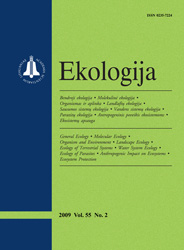 ISSN 0235-7224 ISSN 2029-0586 (online) |
2007 m. Nr. 2.priedas Some aspects of interaction between military activities
and environmental protection on Lithuanian military
grounds
Traditionally, we ideate that military activities and environmentalism are two antagonistic poles. At first sight it looks true.We really have a large number of samples to background this opinion. When the Soviet army left Lithuania in 1993, the inventory of environmental situation showed 2743 sources of actual pollution in the then military lands. Only 14% of all military bases did not contain pollution sources. These are large figures, and they show that in the Soviet period environmental approach was strange for army commanders. Therefore, the specific character of activity, a special status of the strong security on those sites and large territories, especially on military training grounds, supported the formation of specific seminatural and natural habitats with a large number of valuable biodiversity, which expanded to the surrounding regions. Of course, the present Lithuanian army is much more strictly controlled by government and public, therefore environmental problems are currently much more important than before. Certainly, some environmental incidents and problems exist till now, but as part of the NATO forces and of the European Union our military forces should implement all environmental requirements in their activities. Therefore each military base and especially military training grounds had to prepare the base management plan with a focus on environmental problems. This report is intended to present the strides and problems of the Lithuanian army in solving environmental conflicts. Keywords: military activities, environmental pollution, noise, biodiversity, conservation |
Issues:
2011 - Vol.57 No. 1, No. 2 2010 - Vol.56 No. 1-2, No. 3-4 2009 - Vol.55 No. 1, No. 2, No. 3-4 2008 - Vol.54 No. 1, No. 2, No. 3, No. 4 2007 - Vol.53 No. 1, No. 2, No. 2.priedas, No. 3, No. 4 2006 No. 1, No. 2, No. 3, No. 4 2005 No. 1, No. 2, No. 3, No. 4 2004 No. 1, No. 2, No. 3, No. 4 2003 No. 1, No. 2, No. 3, No. 4 2002 No. 1, No. 2, No. 3, No. 4 2001 No. 1, No. 2, No. 3, No. 4 |